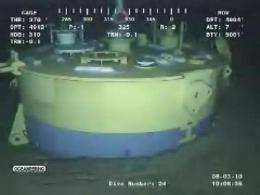BP 'plugs' Gulf of Mexico oil spill (Update)

BP said Wednesday that it had succeeded in plugging a ruptured oil well in the Gulf of Mexico, signalling an end to the worst spill in the United States' history.
The eight-hour "static kill" procedure, which involved pumping heavy drilling fluid known in the industry as mud into the busted well, had gone as planned although the situation would continue to be monitored.
"The well pressure is now being controlled by the hydrostatic pressure of the drilling mud, the desired outcome of the static kill procedure," the British company said in a statement.
The apparent breakthrough came 106 days after a devastating explosion aboard the BP-leased Deepwater Horizon rig on April 20 killed 11 workers and unleashed the biggest oil spill in history.
The 4.9 million barrel leak threatened the fish and wildlife-rich US Gulf coast with environmental ruin and plunged residents of coastal communities into months of anguish over their livelihoods and the region's future.
BP also emerged from the ordeal many billions of dollars poorer and with its reputation tarnished by a succession of failures to stop the leak and public relations gaffes by ousted CEO Tony Hayward.
In its statement, BP said it could yet pump more mud into the well in order to push leaking crude oil back into its source rock.
"The well is now being monitored, per the procedure, to ensure the well remains static," it said. "Further pumping of mud may or may not be required depending on the results observed during monitoring."
It said it would continue to work with the Obama administration's pointman Thad Allen "to determine the next course of action, which includes assessing whether to inject cement into the well via the same route."
Officials had said that complications could arise if the well's casing was found to have leaks, in which case they might have to hold off sealing it with cement until a relief well is complete.
BP said that in any event it will continue to drill a relief well to cut off and seal the well from the bottom, ensuring that the plug is final.
Senior vice president Kent Wells said Tuesday he was encouraged by tests performed before mud was pumped in, which showed the oil could be subdued.
Allen, the Coast Guard admiral who has overseen the government's response to the spill, was emphatic that the static kill "will increase the probability that the relief well will work."
In the long run, "drilling into the annulus and into the casing pipe from below, filling that with mud and then filling that with cement is the only solution to the end of this," he told reporters Tuesday.
The extent of the spill was confirmed when US government experts on Monday announced that the oil had been pouring out at a rate of 62,000 barrels a day -- more than 12 times faster than BP originally admitted.
This was also higher than any previous official estimate, and meant 4.9 million barrels of crude -- more than 205 million gallons -- spewed into the Gulf in the 87 days it took to cap it, making it the biggest maritime spill ever.
If BP is found guilty of negligence, the flow rate means it could face up to 17.6 billion dollars in fines. The firm has also set up a 20 billion dollar fund to pay claims from individuals and businesses hit by the disaster.
In a related development, BP was hit by a 10-billion dollar class action lawsuit for an alleged leak of toxic chemicals from its Texas City, Texas refinery, Britain's Telegraph newspaper reported.
The full economic and environmental cost will not be clear for some time, but a hint of what is to come appeared in a report by researchers at the National Center for Disaster Preparedness (NCDP) at Columbia University.
Of 1,200 coastal Gulf coast residents the researchers surveyed last month, 40 percent said they had been directly exposed to the spill, a third said it had affected their children, and 20 percent said it had hit their wallets.
Parents reported that their children had developed mental, behavioral or physical problems -- everything from respiratory problems and rashes to feelings of sadness or nervousness, difficulty socializing with other children, or trouble getting to sleep.
One in five residents told the Columbia researchers that their household income had fallen, with poor residents -- those who earned less than 25,000 dollars a year -- feeling the pinch more than the better-off.
(c) 2010 AFP




















